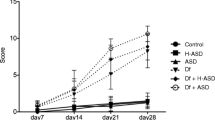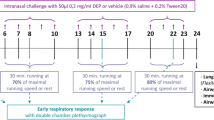Abstract
The aim of this study was to investigate the effect of high-intensity swimming exercise (HISE) on atopic dermatitis (AD). For the study, we established an AD model in BALB/c mice by repeated local exposure of house dust mite extract (Dermatophagoides farinae extract, DFE) and 1-chloro-2,4-dinitrobenzene (CDNB) to the ears. After HISE for 4 weeks, epidermal thickness, mast cell infiltration, serum immunoglobulin E (IgE), and histamine were measured. In addition, the gene expression of interleukin (IL)-5 and IL-31 in the ears was assayed. HISE increased DFE/CDNB-induced AD symptoms based on ear thickness, histopathological analysis, and serum IgE level. Moreover, HISE exercise stimulated mast cell infiltration into the ear, elevation of serum histamine, and DFE/CDNB-induced expression of IL-5 and IL-31 in the ears in the AD model. Taken together, our results indicate the possibility that HISE-induced stress gives rise to AD symptoms through the stimulation of IgE level by increasing IL-5 and IL-31 production.






Similar content being viewed by others
REFERENCES
Benedetto, A.D., R. Agnihothri, L.Y. McGirt, L.G. Bankova, and L.A. Beck. 2009. Atopic dermatitis: a disease caused by innate immune defects? Journal of Investigative Dermatology 129: 14–30.
Incorvaia, C., F. Frati, N. Verna, S. D’Alò, A. Motolese, and S. Pucci. 2008. Allergy and the skin. Clinical and Experimental Immunology 1: S27–S29.
Boguniewicz, M., and D.Y.M. Leung. 2010. Recent insights into atopic dermatitis and implications for management of infectious complications. Journal of Allergy and Clinical Immunology 125: 4–13.
Finkelman, F.D., J.A. Boyce, D. Vercelli, and M.E. Rothenber. 2010. Key advances in mechanisms of asthma, allergy, and immunology in 2009. Journal of Allergy and Clinical Immunology 125: 312–318.
Novak, N., S. Koch, J.P. Allam, and T. Bieber. 2010. Dendritic cells: bridging innate and adaptive immunity in atopic dermatitis. Journal of Allergy and Clinical Immunology 125: 50–59.
Leung, D.Y.M., M. Boguniewicz, M.D. Howell, I. Nomura, and Q.A. Hamid. 2004. New insights into atopic dermatitis. Journal of Clinical Investigation 113: 651–657.
Novak, N., T. Bieber, and D.Y.M. Leung. 2003. Immune mechanisms leading to atopic dermatitis. Journal of Allergy and Clinical Immunology 112: S128–S139.
He, R., M.K. Oyoshi, H. Jin, and R.S. Geha. 2007. Epicutaneous antigen exposure induces a Th17 response that drives airway inflammation after inhalation challenge. Proceedings of the National Academy of Sciences 104: 15817–15822.
Bilsborough, J., D.Y. Leung, M. Maurer, M. Howell, M. Boguniewicz, and L. Yao. 2006. IL-31 is associated with cutaneous lymphocyte antigen-positive skin homing T cells in patients with atopic dermatitis. Journal of Allergy and Clinical Immunology 117: 418–425.
Orita, K., K. Hiramoto, R. Inoue, E.F. Sato, H. Kobayashi, M. Ishii, and M. Inoue. 2010. Strong exercise stress exacerbates dermatitis in atopic model mice, NC/Nga mice, while proper exercise reduces it. Experimental Dermatology 19: 1067–1072.
Kuphal, K.E., E.E. Fibuch, and B.K. Taylor. 2007. Extended swimming exercise reduces inflammatory and peripheral neuropathic pain in rodents. Journal of Pain 8: 989–997.
Mazzardo-Martins, L., D.F. Martins, R. Marcon, U.D. Santos, B. Speckhann, V.M. Gadotti, A.R. Sigwalt, L.G.A. Guglielmo, and A.R.S. Santos. 2010. High-intensity extended swimming exercise reduces pain-related behavior in mice: involvement of endogenous opioids and the serotonergic system. Journal of Pain 1: 1384–1393.
Choi, E.J., S. Lee, H.H. Kim, T. Singh, J.K. Choi, H.G. Choi, W.M. Suh, S.H. Lee, and S.H. Kim. 2011. Generation of regulatory dendritic cells and CD4+Foxp3+ T cells by probiotics administration suppresses immune disorders. Journal of Ethnopharmacology 137: 802–807.
Kim, S.H., S. Lee, K. Suk, H. Bark, C.D. Jun, D.K. Kim, C.H. Choi, and T. Yoshimura. 2007. Discoidin domain receptor 1 mediates collagen-induced nitric oxide production in J774A.1 murine macrophages. Free Radical Biology & Medicine 42: 343–352.
Kim, S.H., C.D. Jun, K. Suk, B.J. Choi, H. Lim, S. Park, S.H. Lee, H.Y. Shin, D.K. Kim, and T.Y. Shin. 2006. Gallic acid inhibits histamine release and pro-inflammatory cytokine production in mast cells. Toxicological Sciences 91: 123–131.
Hammerberg, B., T. Olivry, and S.M. Orton. 2001. Skin mast cell histamine release following stem cell factor and high-affinity immunoglobulin E receptor cross-linking in dogs with atopic dermatitis. Veterinary Dermatology 12: 339–346.
Cooper, C.E., N.B. Vollaard, T. Choueiri, and M.T. Wilson. 2002. Exercise, free radicals and oxidative stress. Biochemical Society Transactions 30: 280–285.
American Diabetes Association. 1993. Exercise and NIDDM. Diabetes Care 16: 54–58.
Sen, C.K. 1999. Glutathione homeostasis in response to exercise training and nutritional supplements. Molecular and Cellular Biochemistry 196: 31–42.
Sen, C.K., and L. Packer. 2000. Thiol homeostasis and supplements in physical exercise. The American Journal of Clinical Nutrition 72: S653–S669.
Hiramoto, K., H. Kobayashi, A. Sekiyama, F.E. Sato, D. Tsuruta, and M. Ishii. 2013. Mild exercise suppresses exacerbation of dermatitis by increasing cleavage of the β-endorphin from proopiomelanocortin in NC/Nga mice. Journal of Clinical Biochemistry and Nutrition 52: 58–63.
Nakazawa, M., N. Sugi, H. Kawaguchi, N. Ishii, H. Nakajima, and M. Minami. 1997. Predominance of type 2 cytokine-producing CD4+ and CD8+ cells in patients with atopic dermatitis. Journal of Allergy and Clinical Immunology 99: 673–682.
Beck, L.A., M. Boguniewicz, T. Hata, L.C. Schneider, J. Hanifin, R. Gallo, A.S. Paller, S. Lieff, J. Reese, D. Zaccaro, H. Milgrom, K.C. Barnes, and D.Y.M. Leung. 2009. Phenotype of atopic dermatitis subjects with a history of eczema herpeticum. Journal of Allergy and Clinical Immunology 124: 260–269.
Salt, B.H., M. Boguniewicz, and D.Y. Leung. 2007. Severe refractory atopic dermatitis in adults is highly atopic. Journal of Allergy and Clinical Immunology 119: 508–509.
Kang, J.S., W.K. Yoon, M.H. Han, H. Lee, C.W. Lee, K.H. Lee, S.B. Han, K. Lee, K.H. Yang, S.K. Park, and H.M. Kim. 2008. Inhibition of atopic dermatitis by topical application of silymarin in NC/Nga mice. International Immunopharmacology 8: 1475–1480.
Matsuoka, H., N. Maki, S. Yoshida, M. Arai, J. Wang, Y. Oikawa, T. Ikeda, N. Hirota, H. Nakagawa, and A. Ishii. 2003. A mouse model of the atopic eczema/dermatitis syndrome by repeated application of a crude extract of house-dust mite dermatophagoides farina. Allergy 58: 139–145.
Bradding, P., J.A. Roberts, K.M. Britten, S. Montefort, R. Djukanovic, R. Mueller, C.H. Heusser, P.H. Howarth, and S.T. Holgate. 1994. Interleukin-4, -5, and -6 and tumor necrosis factor-alpha in normal and asthmatic airways: evidence for the human mast cell as a source of these cytokines. American Journal of Respiratory Cell and Molecular Biology 10: 471–480.
Shen, H.H., S.I. Ochkur, M.P. McGarry, J.R. Crosby, E.M. Hines, M.T. Borchers, H. Wang, T.L. Biechelle, K.R. O’Neill, T.L. Ansay, D.C. Colbert, S.A. Cormier, J.P. Justice, N.A. Lee, and J.J. Lee. 2003. A causative relationship exists between eosinophils and the development of allergic pulmonary pathologies in the mouse. Journal of Immunology 170: 3296–3305.
Lee, G.R., and R.A. Flavell. 2004. Transgenic mice which overproduce Th2 cytokines develop spontaneous atopic dermatitis and asthma. International Immunology 16: 1155–1160.
Simon, D., S. Von Gunten, S. Borelli, L.R. Braathen, and H.U. Simon. 2003. The interleukin-13 production by peripheral blood T cells from atopic dermatitis patients does not require CD2 costimulation. International Archives of Allergy and Immunology 132: 148–155.
Jeong, C.W., K.S. Ahn, N.K. Rho, Y.D. Park, D.Y. Lee, J.H. Lee, E.S. Lee, and J.M. Yang. 2003. Differential in vivo cytokine mRNA expression in lesional skin of intrinsic vs. extrinsic atopic dermatitis patients using semiquantitative RT-PCR. Clinical and Experimental Allergy 33: 1717–1724.
Spergel, J.M., E. Mizoguchi, H. Oettgen, A.K. Bhan, and R.S. Geha. 1999. Roles of TH1 and TH2 cytokines in a murine model of allergic dermatitis. Journal of Clinical Investigation 103: 1103–1111.
Brandt, E.B., and U. Sivaprasad. 2011. Th2 cytokines and atopic dermatitis. Journal of Clinical & Cellular Immunology 2: 110–134.
Choi, E.J., S. Lee, J.S. Hwang, S.H. Im, C.D. Jun, H.S. Lee, and S.H. Kim. 2011. DA-9601 suppresses 2,4-dinitrochlorobenzene and dust mite extract-induced atopic dermatitis-like skin lesions. International Immunopharmacology 11: 1260–1264.
Dillon, S.R., C. Sprecher, A. Hammond, J. Bilsborough, M. Rosenfeld-Franklin, S.R. Presnell, H.S. Haugen, M. Maurer, B. Harder, J. Johnston, S. Bort, S. Mudri, J.L. Kuijper, T. Bukowski, P. Shea, D.L. Dong, M. Dasovich, F.J. Grant, L. Lockwood, S.D. Levin, C. LeCiel, K. Waggie, H. Day, S. Topouzis, J. Kramer, R. Kuestner, Z. Chen, D. Foster, J. Parrish-Novak, and J.A. Gross. 2004. Interleukin 31, a cytokine produced by activated T cells, induces dermatitis in mice. Nature Immunology 5: 752–760.
Diveu, C., A.H. Lak-Hal, J. Froger, E. Ravon, L. Grimaud, F. Barbier, J. Hermann, H. Gascan, and S. Chevalier. 2004. Predominant expression of the long isoform of GP130-like (GPL) receptor is required for interleukin-31 signaling. European Cytokine Network 15: 291–302.
Sonkoly, E., A. Muller, A. Lauerma, A. Pivarcsi, H. Soto, L. Kemeny, H. Alenius, M.C. Dieu-Nosjean, S. Meller, J. Rieker, M. Steinhoff, T.K. Hoffmann, T. Ruzicka, A. Zlotnik, and B. Homey. 2006. IL-31: a new link between T cell and pruritus in atopic skin inflammation. American College of Allergy, Asthma and Immunology 2: 411–417.
ACKNOWLEDGMENTS
This work was supported by the National Research Foundation of Korea Grant funded by the Korean Government (NRF-2012S1A5A8024395) and by the “Cooperative Research Program for Agriculture Science & Technology Development (Project No. 009773)” Rural Development Administration, Republic of Korea.
Author information
Authors and Affiliations
Corresponding author
Additional information
Sang-Hyun Kim and Eun-Kyung Kim contributed equally to this work.
Rights and permissions
About this article
Cite this article
Kim, SH., Kim, EK. & Choi, EJ. High-Intensity Swimming Exercise Increases Dust Mite Extract and 1-Chloro-2,4-Dinitrobenzene-Derived Atopic Dermatitis in BALB/c Mice. Inflammation 37, 1179–1185 (2014). https://doi.org/10.1007/s10753-014-9843-z
Published:
Issue Date:
DOI: https://doi.org/10.1007/s10753-014-9843-z




